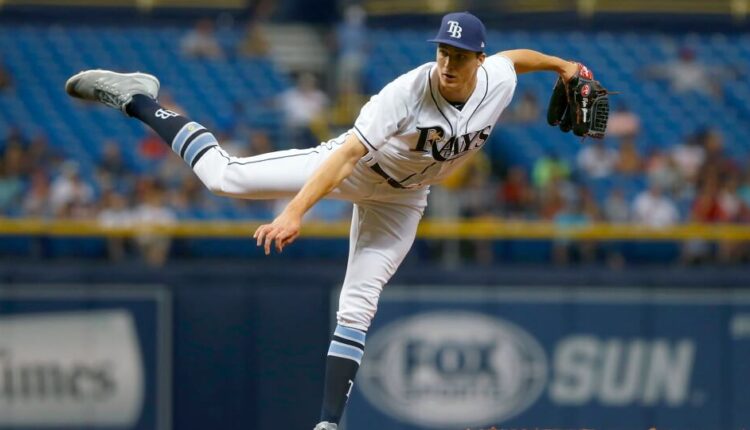Nic Civale is a Doctor of Physical Therapy and former NCAA Division I Baseball player. He combines his knowledge of anatomy and physiology with that of baseball mechanics to provide expectations for injured players. Utilize The MLB Injury Report to make the most of your fantasy season.
What?! Your league is not using Fantrax? Inconceivable! Check out everything Fantrax has to offer and I’m sure you’ll come around to our way of thinking.
MLB Injury Report: A Sticky Situation
The Ulnar Collateral Ligament (UCL) is the most talked-about and feared ligament in all of baseball. Its injury can lead to Tommy John Surgery and can keep a pitcher off the mound for 16 months or more. Even position players can miss 12+ months in their recovery from this dreaded surgery. Today, we attempt to make clear the link between the usage of sticky, foreign substances in Major League Baseball, and UCL injury. This piece is meant to be medically informative, no matter your personal feelings on whether substances should be allowed, or if the incumbent rules pertaining to them are appropriate.
Friction
To begin the link between foreign substances and UCL injuries, we are going to start at the hand. The interaction between hand and baseball determines success for a pitcher. The job of the hand, primarily, is to guide the ball towards home plate. The reason hands are so effective in completing this task is due to a simple element of physics; friction. In order to create spin, and guide a smooth leather sphere through the air towards a target, the hand is uniquely ideal. It conforms around a baseball in a way that it can appropriately angle and spin it to create a desired flight path.
Now, this is not groundbreaking news. But as we come to realize how necessary friction is with pitching, we start to appreciate just how much our bodies rely on it. Whether a pitcher is throwing a 4-seam fastball or a knuckle-curve, increased friction on the baseball allows for decreased grip strength. If the ball sticks to the hand better, the pitcher doesn’t have to hold on so tightly. The stability and strength that is generated in our hands, is immensely related to another scary body part for pitchers… the forearm flexor.
Forearm Flexors
Forearm flexor muscles span the length of the lower arm, from the base of our hands (palmar side) to the medial elbow. The more proximal attachment in the elbow is located on the medial epicondyle. If you are looking for a frame of reference for where that may be, find your “funny bone” region, and move closer towards the “elbow pit” area. The bony prominence you are feeling is your medial epicondyle. If you then flex your forearm -or bring your palm towards your forearm- you may feel the forearm flexor tendon begin to tense.
So now we have this inverse relationship between external friction and the need for grip strength. And we have a direct relationship between grip strength and muscle contraction in the forearm. Following this path, decreased friction = increased need for grip strength = increased need for forearm muscle contraction. Once again, it’s important to point out that regardless of how you feel about the morality of players using substances to improve grip, there are many around the league who have suddenly lost a significant amount of friction when gripping a baseball. If electromagnetic studies on forearm muscle usages were being conducted during major league games, I believe we would see some very interesting and convincing results stating that forearm flexor usage has increased dramatically.
The UCL
So we can comfortably say forearm flexor muscle usage should be on the rise due to a lack of foreign sticky substance to create friction on the baseball. It is a fair assumption, considering Tyler Glasnow has already been extremely vocal about how his body responded to changes. Regarding the sudden unavailability of sticky substances on the baseball, he stated, “I’m telling you, I truly believe that’s why I got hurt,” via the Tampa Bay Times. Finally, we shift back to the protagonist of our story, the main character, the UCL. Go back to palpating your funny bone and your medial epicondyle. Remember how important that spot is for the forearm flexor? It is its entire base of support proximally. This epicondyle is also home to one of the attachments of the UCL. They are neighbors, and when one is inflamed, the other gets encroached upon.
Not only that, but the UCL and forearm flexors have overlapping function. It is the primary job of the UCL to prevent separation of the elbow joint. Ligaments are engineered to maintain the structural integrity of joints. The forearm flexors also play a part in the preservation of joint integrity. So when the forearm flexor is overworked, weakened, inflamed, or torn, increased stress goes into the UCL. This is why UCL injuries are so correlated with flexor strains and tears. Not because the two structures are one, in the same; they’re not even technically attached. But they do share responsibilities.
Conclusion
So MLB has decided to enforce a rule that they created years ago. Auspicious timing, on the verge of a CBA… But what needs to be acknowledged here is that pitchers who once relied on substances for friction will likely need to change their mechanics drastically. The ultimate conclusion comes down to a simple formula based on biomechanics.
Decreased external friction = increased need for grip strength
Increased grip strength = Increased forearm flexor stresses = Increased chance for UCL overload and damage.
The equation is long, but simple. The lack of friction will cause many pitchers to go back to the drawing board mid-season; something no one had expected or planned for. One thing that seemingly everyone agrees on is that a source of grip on the ball needs to be standardized. Let’s figure this out MLB.
Baseball is better with better players playing baseball… don’t let them get hurt.
For more great Fantasy Baseball check out Mick Ciallela’s Rest of Season Rankings! Mick was the No. 1 Ranker on FantasyPros.com for the 2020 MLB season.
Fantrax was one of the fastest-growing fantasy sites of 2020, and we’re not stopping now. With multi-team trades, designated commissioner/league managers, and drag/drop easy click methods, Fantrax is sure to excite the serious fantasy sports fan – sign up now for a free year at Fantrax.com.



Friction very important in another issue not related to baseball. Without friction, none of us would be here :).